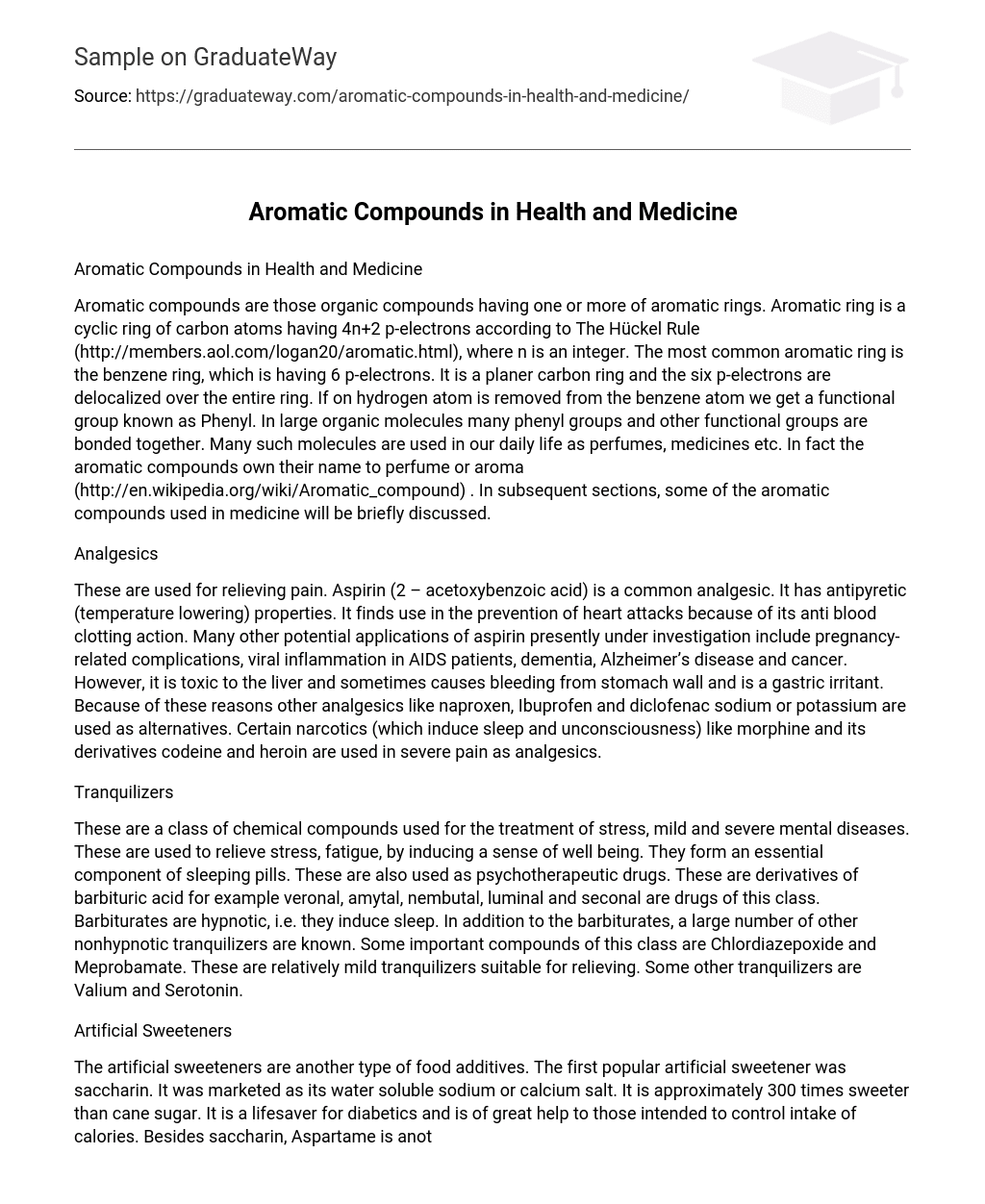Aromatic Compounds in Health and Medicine
Aromatic compounds are those organic compounds having one or more of aromatic rings. Aromatic ring is a cyclic ring of carbon atoms having 4n+2 p-electrons according to The Hückel Rule (http://members.aol.com/logan20/aromatic.html), where n is an integer. The most common aromatic ring is the benzene ring, which is having 6 p-electrons. It is a planer carbon ring and the six p-electrons are delocalized over the entire ring. If on hydrogen atom is removed from the benzene atom we get a functional group known as Phenyl. In large organic molecules many phenyl groups and other functional groups are bonded together. Many such molecules are used in our daily life as perfumes, medicines etc. In fact the aromatic compounds own their name to perfume or aroma (http://en.wikipedia.org/wiki/Aromatic_compound) . In subsequent sections, some of the aromatic compounds used in medicine will be briefly discussed.
Analgesics
These are used for relieving pain. Aspirin (2 – acetoxybenzoic acid) is a common analgesic. It has antipyretic (temperature lowering) properties. It finds use in the prevention of heart attacks because of its anti blood clotting action. Many other potential applications of aspirin presently under investigation include pregnancy-related complications, viral inflammation in AIDS patients, dementia, Alzheimer’s disease and cancer. However, it is toxic to the liver and sometimes causes bleeding from stomach wall and is a gastric irritant. Because of these reasons other analgesics like naproxen, Ibuprofen and diclofenac sodium or potassium are used as alternatives. Certain narcotics (which induce sleep and unconsciousness) like morphine and its derivatives codeine and heroin are used in severe pain as analgesics.
Tranquilizers
These are a class of chemical compounds used for the treatment of stress, mild and severe mental diseases. These are used to relieve stress, fatigue, by inducing a sense of well being. They form an essential component of sleeping pills. These are also used as psychotherapeutic drugs. These are derivatives of barbituric acid for example veronal, amytal, nembutal, luminal and seconal are drugs of this class. Barbiturates are hypnotic, i.e. they induce sleep. In addition to the barbiturates, a large number of other nonhypnotic tranquilizers are known. Some important compounds of this class are Chlordiazepoxide and Meprobamate. These are relatively mild tranquilizers suitable for relieving. Some other tranquilizers are Valium and Serotonin.
Artificial Sweeteners
The artificial sweeteners are another type of food additives. The first popular artificial sweetener was saccharin. It was marketed as its water soluble sodium or calcium salt. It is approximately 300 times sweeter than cane sugar. It is a lifesaver for diabetics and is of great help to those intended to control intake of calories. Besides saccharin, Aspartame is another artificial sweetener. It is unstable at cooking temperatures; therefore, it is used as a sugar substitute in cold foods and soft drinks.
Antioxidants
Antioxidants are the important and necessary food additives. These compounds retard the action of oxygen on the food and thereby help in its preservation. These act as sacrificial materials, i.e., these are more reactive towards oxygen than are the materials they are protecting. They also reduce the rate of involvement of free radicals in the aging process. The two most familiar antioxidants used are butylated hydroxy toluene (BHT) and butylatedhydroxy anisole (BHA). The additon of BHA to butter increases its storage life from months to years. Sometimes BHT and BHA are added in combination with citric or ascorbic acids to produce a more active synergistic effect.
Preservatives
These are used to preserve palatability and wholesomeness of many food items for very prolonged period of time. The preservatives prevent spoilage of food due to microbial growth. The most common preservative used is sodium benzoate, C6H5COONa. It is metabolized by conversion to C6H5CONHCH2COOH (hippuric acid), which ultimately is excreted in the urine.
Conclusions:
A brief description of some of the aromatic compound as food and medicine items has been presented. So common are these compounds in our life that it will be a very long paper describing all of these. However, it is undisputed fact that without aromatic compounds we can not imagine a healthy and enjoying life.
References:
http://en.wikipedia.org/wiki/Aromatic_compound
http://members.aol.com/logan20/aromatic.html





